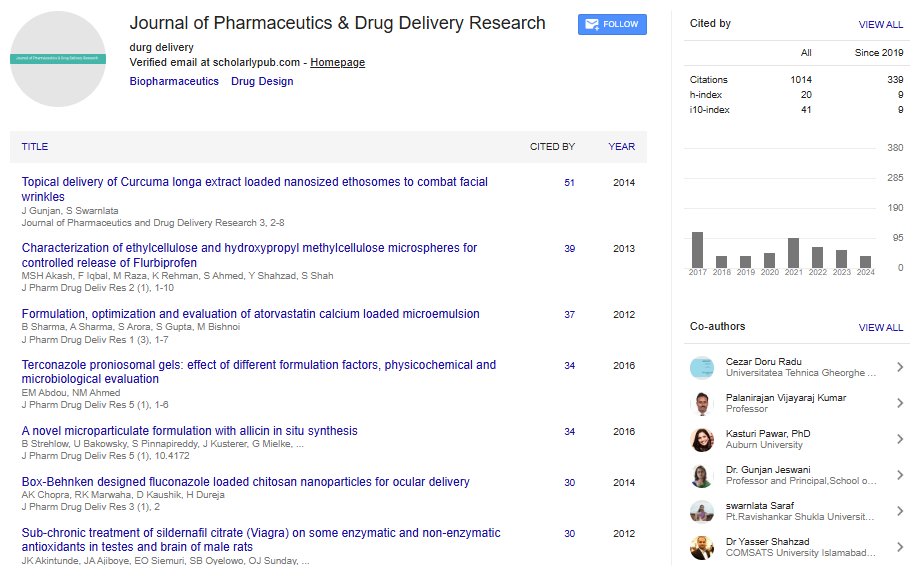Perspective, J Pharm Drug Deliv Res Vol: 13 Issue: 5
The Role of Biopharmaceutics in Drug Development: Bridging Pharmaceutical Science and Clinical Outcomes
Florian Lemaitre*
1Department of Pharmaceutics, University of Mississippi, Mississippi, USA
*Corresponding Author: Florian Lemaitre,
Department of Pharmaceutics,
University of Mississippi, Mississippi, USA
E-mail: lemaitref48@gmail.com
Received date: 26 August, 2024, Manuscript No. JPDDR-24-151928;
Editor assigned date: 28 August, 2024, PreQC No. JPDDR-24-151928 (PQ);
Reviewed date: 11 September, 2024, QC No. JPDDR-24-151928;
Revised date: 18 September, 2024, Manuscript No. JPDDR-24-151928 (R);
Published date: 26 September, 2024, DOI: 10.4172/2325-9604.1000295
Citation: Lemaitre F (2024) The Role of Biopharmaceutics in Drug Development: Bridging Pharmaceutical Science and Clinical Outcomes. J Pharm Drug Deliv Res 13:5.
Description
Biopharmaceutics is a precarious field in pharmaceutical science that examines the relationship between the physical and chemical properties of drugs, their dosage forms and the body's response. By bridging fundamental scientific concepts with clinical applications, biopharmaceutics plays a key role in drug development and the improvement of patient outcomes. This article discovers the foundational principles of biopharmaceutics, its applications and its impact on developing safe and effective medications.
The field of biopharmaceutics is primarily concerned with how drugs are Absorbed, Distributed, Metabolized and Excreted (ADME) in the body. Key factors include the drug's solubility, permeability and stability, which influence how a medication is absorbed through the Gastrointestinal (GI) tract and delivered to the bloodstream. Understanding these properties allows scientists to predict how a drug will behave in the body, thus optimizing dosage forms and delivery methods.
The bioavailability of a drug, which measures the fraction that reaches the systemic circulation in an active form, is an essential concept in biopharmaceutics. A drug with high bioavailability can be administered at a lower dose while achieving the desired therapeutic effect. Conversely, drugs with poor bioavailability may require formulation adjustments, such as nano-formulations or liposomal delivery systems, to enhance their effectiveness.
Biopharmaceutics has an insightful impact on drug formulation and design, as well as the evaluation of new drug candidates. For instance, many drugs face challenges related to solubility or stability, which can prevent them from being adequately absorbed. In response, biopharmaceutical researchers employ techniques such as pH modification, particle size reduction and the development of prodrugs (inactive compounds that convert to active drugs in the body) to improve absorption.
Another application is in controlled and targeted drug delivery systems, which aim to release drugs at specific sites in the body or over an extended period. Controlled release formulations help maintain therapeutic levels of a drug, reducing the frequency of dosing and improving patient adherence. Targeted drug delivery minimizes side effects by concentrating the drug in the intended area, as seen in cancer therapies that use nanoparticles to deliver chemotherapy directly to tumor cells.
Biopharmaceutics also plays an essential role in the development of generic drugs, which must demonstrate bioequivalence to brand-name medications. Bioequivalence studies compare the pharmacokinetic properties, such as peak concentration and time to reach it, between the generic and the reference product. This ensures that patients can trust the generic medication to perform in the same way as the brandname drug, without additional risks.
In the generic drug market, biopharmaceutics aids in creating affordable alternatives to branded medications without compromising quality or effectiveness. This field’s stringent standards for bioequivalence testing are essential in helping to provide safe, accessible medications to patients worldwide.
Regulatory agencies, including the U.S. Food and Drug Administration (FDA) and the European Medicines Agency (EMA), rely on biopharmaceutic data when evaluating new drug applications. Biopharmaceutic studies ensure that drugs meet safety and efficacy standards before they are approved for public use. These regulations also cover specific drug properties such as solubility, dissolution rate and stability, which can directly affect a drug's bioavailability and overall effectiveness.
Patient safety is always at the lead of biopharmaceutic research. By understanding how different patient populations respond to various drugs, researchers can tailor treatments to minimize adverse effects. For instance, personalized medicine approaches may be used to create formulations that account for genetic differences in drug metabolism, leading to safer and more effective therapies.
Conclusion
Biopharmaceutics is a vital field that supports the development, optimization and regulation of pharmaceuticals. By focusing on how drug properties influence the body’s response, biopharmaceutics allows scientists and researchers to design formulations that maximize efficacy while minimizing side effects. This field not only advances pharmaceutical science but also improves the quality of healthcare by ensuring that medications are both safe and effective for patients. As new technologies and discoveries emerge, biopharmaceutics will continue to play a central role in enhancing drug delivery and therapeutic outcomes.
 Spanish
Spanish  Chinese
Chinese  Russian
Russian  German
German  French
French  Japanese
Japanese  Portuguese
Portuguese  Hindi
Hindi 
